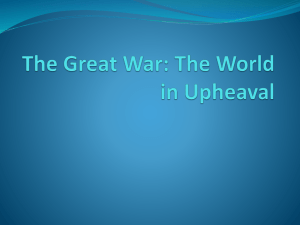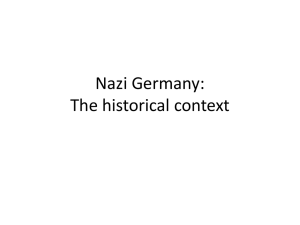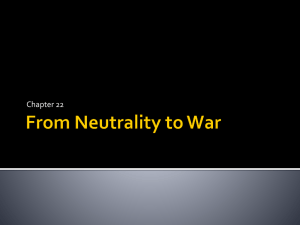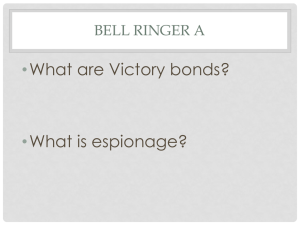Lesson 8: War Aims and Goals for Peace
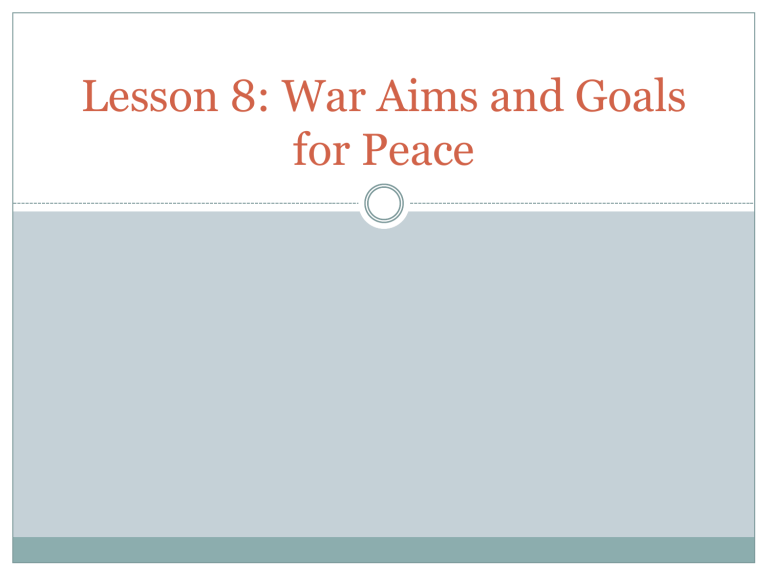
Lesson 8: War Aims and Goals for Peace
Bolshevism
Bolshevism - A radical, revolutionary movement under the leadership of Lenin which seized power in
Russia in 1917. It promoted an anti-capitalist philosophy and supported world revolution and class warfare.
Discussion point:
Bolshevism
What aspects of the Bolshevik Revolution caused it to be feared by Western countries?
Describe the conditions of the working classes that prompted political leaders to fear that the revolution might spread.
A clear understanding of how Bolshevik philosophy and values clashed with traditional liberal Western values is important.
Bolshevism was described as a virus because it was seen to deny or destroy many aspects of contemporary
Western institutions—social, economic, cultural and political.
What were each nations specific aims upon entering WWI and how did these change by the end?
General themes
Most nations’ aims were vague.
Austria was really the only power that had clear war aims: to crush
Serbia and increase its influence in the Balkans.
As war continued, propaganda encouraged hatred and people demanded unconditional victory and territorial concessions from the loser.
Initial war aims tended to fall into three categories:
Nationalist goals
Imperialist goals
Concern for security
How do these compare to the causes of the war?
Initial war aims by Britain
Wanted to crush German militarism – esp. German navy.
Wanted to restore Belgium’s pre-war neutral position.
Wanted to seize Germany’s overseas colonies.
Southern dominions (Australia, New Zealand, South
Africa)wanted these.
Wanted strategic trade-offs with the French and
Russians, including control of Persia and colonial rule over Egypt.
Initial war aims by France
Wanted to crush German military power and to remove any threat to France’s eastern frontier.
This involved regaining Alsace-Lorraine, taking control of
Germany’s Saar region and eliminating any Germany military positions in the Rhineland.
Wanted to strengthen its control of African territories, especially Morocco.
Initial war aims by Italy
Wanted to gain control of areas in Austria-Hungary that were populated by Italian-speaking people.
a) led by Italy Irredentist movement.
Wanted control of other areas, such as the Aegean
Islands, part of the Turkish coast and extension of its
African territory.
Initial war aims by Japan
Wanted to expand its holdings on the Chinese mainland
Sparked by population pressure in Japan
Wanted German colonies in China and also areas under Chinese control, too
Initial war aims by country Russia
Wanted the destruction and punishment of Austria-Hungary and an end to Austrian influence in the Balkans.
Wanted a greater Serbia that would be a Russian client.
Wanted control of the Straits and of Constantinople.
This was agreed to by France and Britain in the secret accords of April,
1915.
Other secret agreements:
Britain and France agreed to divide the Arab lands of the Ottoman Empire among themselves
Russia was promised all of Armenia and more of Turkestan.
History & TOK
How does the experience of war affect a nation's approach to the peace process?
What did Germany hope would be the outcome of the peace settlement?
Initial war aims by Germany
Historian Fritz Fischer claims that Germany was consciously striking out to establish itself as a world power before Russian strength could challenge it.
Mainstream historians see Germany acting much the same way as other European nations: nationalist, imperialist, and concern for its security.
Once war was declared, most agree that Germany sought:
Control of France’s iron producing areas
Control of Poland, the Baltic and Russia’s westernmost regions
This would push Russia back to the borders of Peter the Great
A Mitteleuropa or German dominated central Europe, which would include an economic union of Germany, Belgium, Luxembourg,
Austria-Hungary, Turkey, and possibly Holland and Scandinavia.
1917 as a key year
Enormous sacrifices by civilians and soldiers coupled with an intensive propaganda campaign that vilified the enemy meant that only unconditional victory could b
US entry into WWI; US Aims
President Woodrow Wilson wanted to transform the old war aims
Was a Calvinist and a liberal -- so he views the US as destined or appointed by
God to be the mechanism to uplift the world.
Wanted to defend democracy and for WWI to be a war to end all wars
Lenin published the secret treaties previously signed by the
Triple Entente
Hoped to spark revolution in the west and make for a worldwide communist transformation.
Embarrassed the British and French
Led to a US attempt to purify the war aims via of Woodrow
Wilson’s 14 points used as justification.
Armistice, 1918
Allied military planners ensured, via the armistice demands, that any resumption of fighting by Germany would be impossible
Germany had to pull completely out of Alsace-Lorraine
German troops had to withdraw to 10 km east of the Rhine
Quick evacuation was insisted upon, with all heavy equipment left behind
German navy was to surrender all of its large ships
Germans had no alternative but to accept and hope that the peace conference would result in an improved position for Germany.
Germany military leaders now attempted to save face by supporting the
“stab in the back theory” – that the politicians and not themselves were responsible for Germany’s humiliation.
Hope and reflection: all looked toward the upcoming peace conference in Paris to resolve Europe’s problem and restore order.
The prospects were not good:
Millions lay dead and further millions were maimed and would remain wards of the state.
A generation of leaders lay dead
An influenza epidemic swept the world, killing another 20 million
Families were broken and civilians and soldiers were psychologically shattered.
Though workers had managed to earn raises and keep up with inflation, much of the middle class had not. These people often turned to the radical right for answers
Four empires lay in ruins
Prewar trade patterns had been destroyed and many of those needed to reconstruct them now lay dead.
National minorities who had risen in revolt now wanted freedom.
Source analysis
A cartoon entitled “Peace, perfect peace” by David Low, first published in The Bulletin
(Sydney) on 15 May 1919. The caption reads ‘Signor Orlando has returned to Paris, and the Big Four are in harmony again.’—Cable.
Questions
1.
2.
What message about the Paris
Peace Conference is prompted by the cartoon?
What does it suggest about the ability of the conference to solve the world’s problems?
Source Analysis
Source A
Woodrow Wilson had already revealed, in the Fourteen Points, what he wanted to see emerge out of the war—a Europe whose nationalities would rule themselves as open, democratic societies. Before the end of the war he had declared that the peace should show “no discrimination between those to whom we wish to be just and those to whom we do not wish to be just. It must be justice that plays no favorites …” But any Germans who thought that Wilson’s “justice” meant that they would be treated generously were in for a shock. In the President’s eyes Germany had been wicked, and “justice” demanded that Germany be punished.
Source: Howarth, T. 1993. Twentieth Century World History: The world since 1900. London, UK. Longman. p. 39.
Question
Woodrow Wilson had often spoken about “peace without victory”. Is this reflected in the document? What may have caused him to change his mind?
Source B: British aims
In contrast to France, Britain, even before the great powers met in Paris, had already achieved many of its aims: the German fleet had surrendered, German trade rivalry was no longer a threat and Germany’s colonial empire was liquidated, while the German armies in Western Europe had been driven back into the Reich. Britain’s territorial ambitions lay in the Middle East, not Europe.
In January 1919 Lloyd George envisaged the preservation of a peaceful united Germany as a barrier against Bolshevism. Above all he wanted to avoid long-term British commitments on the continent of Europe and prevent the annexations of German minorities by the Poles or the French creating fresh areas of bitterness, which would sow the seeds of a new war. Inevitably, then, these objectives were fundamentally opposed to the French policy of securing definite guarantees against the
German military revival either by negotiating a long-term Anglo-American military alliance or by a partial dismemberment of the German empire. The logic of British policy pointed in the direction of a peace of reconciliation rather than revenge, but in two key areas, reparations and the question of
German war guilt, Britain adopted a more intransigent line. Lloyd George and Clemenceau agreed in December 1918 that the Kaiser should be tried by an international tribunal for war crimes. Under pressure from the Dominions, who also wanted a share of reparations, the British Delegation at
Paris was authorized to endeavor to secure from Germany the greatest possible indemnity she can pay consistently with the well being of the British Empire and the peace of the world without involving an army of occupation in Germany for its collection.
Source: Williamson, D. 2003. War and Peace: International relations 1919–39. 2nd edn. Tunbridge
Wells, UK. Hodder Murray. p. 24
Question
Why could British aims be seen as moderate?
Source C: French aims
Although the leaders of the three great Allied powers believed Germany was to blame for the war, they disagreed about what to do with her in defeat. The French
Prime Minister, Georges Clemenceau, and the French people knew what they wanted to write into the treaty of peace—revenge, compensation for all they had suffered, and guarantees that a similar war would never happen again. For four years they had believed that the only good German was a dead German. Now they felt that the only safe Germany would be a crippled Germany, stripped of her wealth and most of her armed forces, and separated from France either by the creation of a new state between them or making sure that what remained of the German army stayed well away from the French border. In the east, a line of new states able to defend themselves would take care of any future German ambitions in that direction.
Source: Williamson, D. 2003. War and Peace: International relations 1919–39. 2nd edn. Tunbridge Wells, UK. Hodder Murray. p. 23.
1.
2.
Questions
Identify French aims at the Versailles Conference.
How are these to be accomplished?
Source D: Italian and Japanese aims
The aims of both Japan and Italy were concentrated on maximizing their war-time gains.
Vittorio Orlando, the Italian Prime Minister, was anxious to convince the voters that Italy had done well out of the war, and concentrated initially on attempting to hold the Entente to their promises made in the Treaty of London, as well as demanding the port of Fiume in the Adriatic.
Japan wanted recognition of its territorial gains. The Japanese Government also pushed hard, but ultimately unsuccessfully, to have a racial equality clause included in the Covenant of the
League of Nations. It hoped that this would protect Japanese immigrants in America. Japan’s gains in the war The war has presented Japan with opportunities to increase its power in China and the Pacific region at a time when the energies of the European Powers were absorbed in
Europe. The Japanese declared war on Germany on 23 August. The British had originally intended that the Japanese navy should merely help with convoy duties in the Pacific, but the
Japanese refused to be relegated to a minor role and, much to the alarm of Britain, Australia and the USA, proceeded to seize German territory in the Chinese province of Shantung as well as the German Pacific islands. In January 1915 the Japanese pushed their luck further and presented China with the Twenty-One Demands, which not only included the recognition of the
Japanese claims to Shantung and southern Manchuria but also proposed that the Chinese government should appoint Japanese advisers. This last demand would have turned China into a Japanese protectorate and was only dropped after strong British and American objections.
However, the rest of the demands were accepted by China in May 1915.
Source: Williamson, D. 2003. War and Peace: International relations 1919–39. 2nd edn.
Tunbridge Wells, UK. Hodder Murray. p. 25.
1.
2.
Questions
Identify the aims of Japan and Italy.
Who would oppose these claims?

